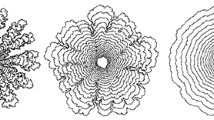Abstract.
Complex spatio-temporal patterns of cell clusters were observed in colonies of chemotactic bacteria such as Escherichia coli or Sallmonella typhimurium. The production of a potent chemoattractant by the bacteria themselves as a reaction to certain nutrients is the essential factor for this pattern formation. Additional collective dynamics, such as collective translation and rotation of bacterial clusters were reported from experiments on bacterial colonies. Motivated by this observations we suggest a simple model for the description of bacterial colonies using the concept of active Brownian particles. Individual based models represent an interesting alternative to the usually employed mean field chemotaxis-diffusion equations (Keller-Segel model) as they allow us to study the macroscopic pattern formation of the colony, the collective dynamics of bacterial ensembles, as well as the microscopic dynamics of individual cells. In this paper we derive microscopic model equations from basic assumptions about bacterial dynamics, discuss the parameter choice by comparison with biological data and analyse the macroscopic and microscopic dynamics of the system. Finally we extend the model by a velocity-alignment (swarming) interaction which leads to novel collective dynamics in the system.
Similar content being viewed by others
References
E.F. Keller, L.A. Segel, J. Theor. Biol. 30, 225 (1971)
E.F. Keller, L.A. Segel, J. Theor. Biol. 30, 235 (1971)
R. Tyson, S.R. Lubkin, J.D. Murray, J. Math. Biol. 38, 359 (1999)
R. Tyson, S.R. Lubkin, J.D Murray, Proc. Royal Soc. London B 266, 299 (1999)
M. Matsushita, J. Wakita, H. Itoh, K. Watanabe, T. Arai, T. Matsuyama, H. Sakaguchi, M. Mimura, Physica A 274, 190 (1999)
Y. Kozlovsky, I. Cohen, I. Golding, E. Ben-Jacob, Phys. Rev. E 59, 7025 (1999)
E.O. Budrene, H.C. Berg, Nature 349, 630 (1991)
E.O. Budrene, H.C. Berg, Nature 376, 49 (1995)
A. Czirók, E. Ben-Jacob, I. Cohen, T. Vicsek, Phys. Rev. E 54, 1791 (1996)
M. Eisenbach, Chemotaxis (World Scientific Publishing, 2004)
W. Ebeling, F. Schweitzer, B. Tilch, BioSystems 49, 17 (1999)
U. Erdmann, W. Ebeling, L. Schimansky-Geier, F. Schweitzer, Eur. Phys. J. B 15, 105 (2000)
U. Erdmann, W. Ebeling, V.S. Anishchenko, Phys. Rev. E 65, 061106 (2002)
W. Ebeling, Physica A 314, 92 (2002)
B.A. Mello, L. Shaw, Y. Tu, Biophys. J. 87, 1578 (2004)
S.-H. Kim, W. Wang, K.K. Kim, Proc. Nation. Acad. Sci. USA 99, 11611 (2002)
V. Sourjik, H.C. Berg, Proc. Nation. Acad. Sci. USA 99, 123 (2002)
E. Ben-Jacob, I. Cohen, H. Levine, Adv. Phys. 49, 395 (2000)
J.D. Murray, Mathematical Biology I, 3 edn. (Springer, Berlin, 2004)
F. Schweitzer, L. Schimansky-Geier, Physica A 206, 359 (1994)
A.S. Mikhailov, D. Meinköhn, Self-motion in physico-chemical systems far from equilibrium, Vol. 484, Lecture Notes in Physics (Springer-Verlag, Berlin, 1997), p. 334
M. Loferer-Krösbacher, J. Klima, R. Psenner, Appl. Envir. Microbiol. 64, 688 (1997)
A. Czirók, T. Vicsek, Physica A 281, 17 (2000)
M.R. D'Orsogna, Y.L. Chuang, A.L. Bertozzi, L.S. Chayes, Phys. Rev. Lett. 96, 104302 (2006)
U. Erdmann, W. Ebeling, L. Schimansky-Geier, F. Schweitzer, Eur. Phys. J. B, 15, 105 (2000)
L. Schimansky-Geier, W. Ebeling, U. Erdmann, Acta Phys. Polon. 36, 1757 (2005)
W.Q. Zhu, M. Lin Deng, Phys. A: Stat. Mech. Appl. 354, 127 (2005)
U. Erdmann, W. Ebeling, Fluc. Noise Lett. 3, 145 (2003)
T.J. Pedley, J.O. Kessler, Ann. Rev. Fluid Mech. 24, 313 (1992)
C.M. Pooley, G.P. Alexander, J.M Yeomans, Swimming with a friend at low reynolds number, 0705.3612 (2007)
Z. Csahók, A. Czirók, Physica A 243, 304 (1997)
P. Romanczuk, U. Erdmann, PRL (2007) (submitted)
G.V. Soni, B.M. Jaffar Ali, Y. Hatwalne, G.V. Shivashankar, Biophys. J. 84, 2634 (2003)
F. Peruani, A. Deutsch, M. Bar, Phys. Rev. E (Stat. Nonl. Soft Matter Phys.) 74, 030904–4 (2006)
Author information
Authors and Affiliations
Corresponding author
Rights and permissions
About this article
Cite this article
Romanczuk, P., Erdmann, U., Engel, H. et al. Beyond the Keller-Segel model. Eur. Phys. J. Spec. Top. 157, 61–77 (2008). https://doi.org/10.1140/epjst/e2008-00631-1
Issue Date:
DOI: https://doi.org/10.1140/epjst/e2008-00631-1




